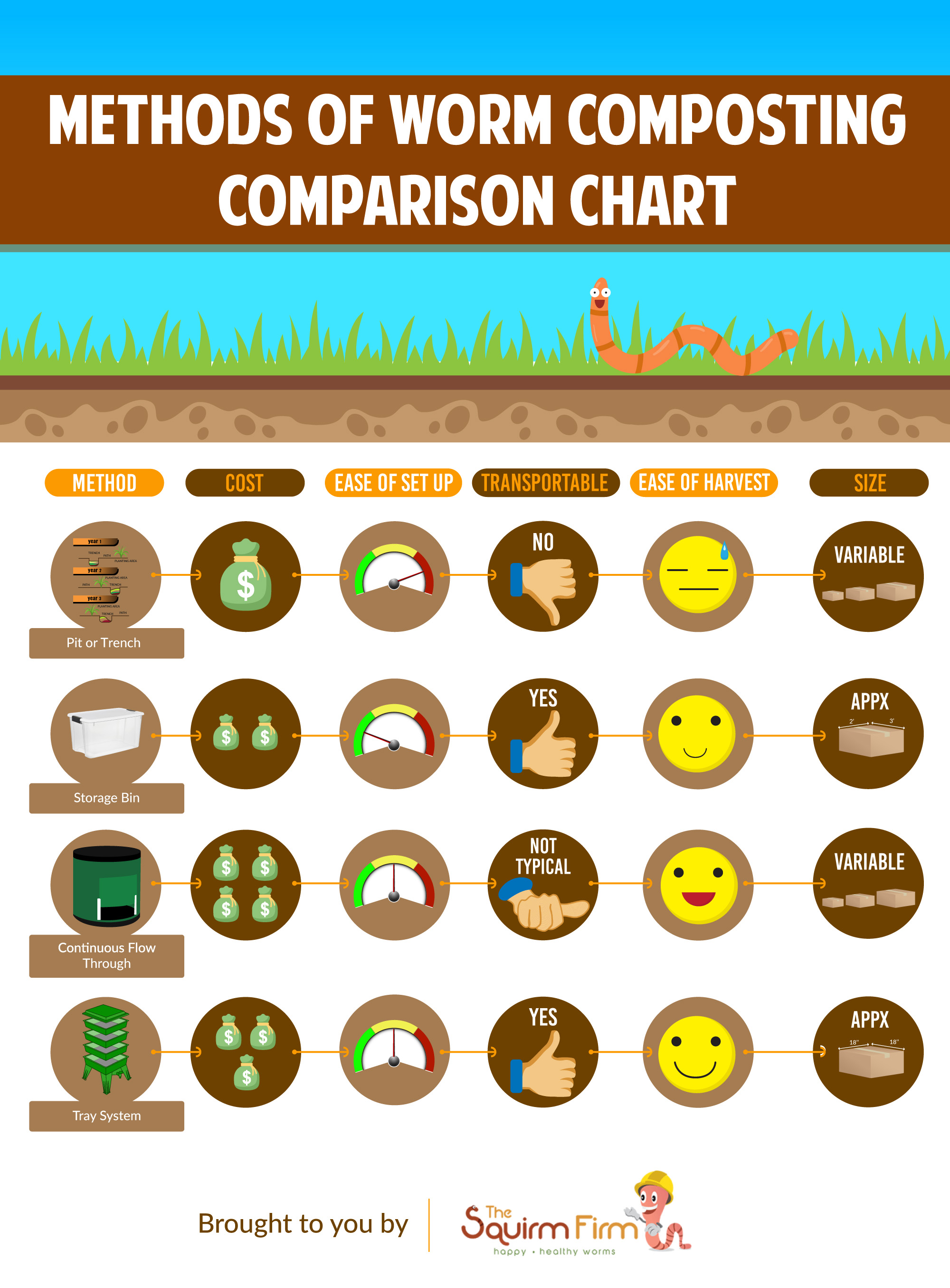We’d all agree that worm composting really isn’t a one-size-fits-all type of hobby. We all come to this practice with unique purposes, perspectives, and plans in mind.
For example, we’ve got the little ones who raise worms as pets, students curious about the natural world and the inner workings of its creatures. Then there are parents composting to maintain a healthy and environmentally responsible home. In and amongst them all are those living the easy life, enjoying what a worm herd provides for fishing or gardening.
Fortunately, vermicomposting can be tailored to perfectly suit anyone’s lifestyle.
The Origins of Worm Composting
Nature just has a way, doesn’t it? Eisenia fetida (red worms) have been doing their amazingly transformative composting thing since the dawn of their creation–whereas humans, by comparison, have been a LOT slower on the uptake. In fact, methodized worm farming first came into practice in the early 20th century. Charles Darwin’s curiosity and experiments using worms advanced the perception of their being considered pests up to what it is today–worms as creatures of great potential.
“It may be doubted whether there are many other animals
which have played so important a part in the history of the world,
as have these lowly organized creatures.”
– Charles Darwin 1881
The earliest vermiculture pioneers used worms to improve the health of soil as well as to reduce their impact on the waste stream. It was soon recognized as a remarkably sustainable practice and adopted by farmers, gardeners, and worm lovers of all kinds.
Modern Worm Composting
While humans never cease to change, interestingly, there is little evidence of Eisenia fetida ever changing by way of evolution. This means red wigglers consume and transform organic matter into nutrient-rich fertilizer just as they have for ages on end.
Of course, nature has always solved environmental “problems” in astounding ways. And now, after many centuries of observation, we combine technology and human ingenuity to harness and implement similar solutions in our own homes and workplaces.
These days, we raise them, breed them, and feed them in ways that take advantage of present-day resources and serve the many unique needs and whims of modern man.
Even popular culture touts vermicomposting as one of the very best ways to tackle the mounting issues of efficient waste disposal. Not only does worm composting relieve us of volumes of unnecessary trash, but it also serves to enrich depleted soil in the process.
It’s the proverbial win-win!
Vermicomposting at Home
Those eager to try worm composting may be surprised to find just how many methods there are for putting red wigglers to work in your own backyard (kitchen, garage, etc.).
Here, I’ll share four of the most common and foolproof ways to incorporate a system of your own to transform household waste into rich and natural fertilizer.
First, let me show you how easy it is and how little it takes. There are four basic elements to every successful worm composting method. These include the following:
- A designated area
- Bedding materials
- Food materials
- Composting worms
As you can clearly see, the list of requirements is short and simple. To top it off, there are hardly any hard and fast rules when running your own worm composting system. Sweet!
Four Popular Methods of Vermicomposting
Share this image on your site and please include attribution to The Squirm Firm:

With such a broad sweep of general requirements needed for worm composting, it’s no surprise that very different methods are successfully being used around the world. The one that works best for you will depend upon your climate, resources, and just how much effort you wish to put into the ongoing process.
Trench or Pit Method
This is a method by which you can use an in-ground space to house all of the activity of your worm herd. The worms remain underground protected from the elements by layers of brown materials and green organic matter. These materials are slowly consumed as food while also providing habitat and insulation.
To get a trench or pit system such as this up and running requires quite a bit of manual labor. You can expect the digging to be the most laborious step in the process. It must be deep enough to contain layers of bedding, food, and insulation to prevent freezing when winter hits.
The surface area of a pit or trench can be far greater than that of most other methods. Therefore, once it is well established, it may yield the greatest amount of worms and vermicompost. Of course, maintaining a successful pit requires the addition of a high volume of organic matter added on a regular basis. It also takes a watchful eye for critters and the potentially dangerous effects of weather.
This method is best for those living in a moderate climate where Eisenia fetida can survive year round. Still, if you provide proper care, insulation, and forethought, even those in harsher conditions can successfully use a trench or pit for worm composting.
Storage Bin Worm Composting
Perhaps the very least labor-intensive option of all is that which transforms a regular old plastic tub into a worm compost system. With or without holes drilled into the sides for airflow or drainage, an opaque storage bin with a tight fitting lid may be the perfect worm composter for a beginner.
One thing I like about a storage bin worm composter is that it is relatively easy to move indoors or out as the weather permits. It is also small and inconspicuous enough to tuck away, yet large enough to accommodate the volume of waste a small family might otherwise throw into the trash.
There are a few things to keep in mind when deciding if this method is best for you:
- A storage bin has great but limited potential in the quantity of worms it can contain, and therefore the speed at which it processes materials into compost.
- A storage bin full of moist rich compost is exceedingly heavy. Regular harvesting is required for both the health of the worms as well your back!
- A small storage bin does not allow for much space for the worms to escape to if poor conditions become an issue.
Continuous Flow-Through (CFT) Composter
Considered by some to be the most hands-off approach, the continuous flow-through composter system allows large volumes of vermicompost to be harvested on a much more regular basis than other systems.
For that reason, among others, the CFT is often utilized by the large-scale worm composting operations that process huge amounts of feed each day.
A CFT system takes advantage of the red worms’ natural propensity to live in the top 6-8 inches of their bedding. Food is added right on top where the worms like to stay. The casts accumulate until they are harvested from below without ever disturbing the worms.
This method costs considerably more up front to build or purchase, but may be the most time and energy efficient in the long run. Both small and large scale CFT options available.
Rotating Tray System
The rotating tray system alone combines both form and function with an added measure of adaptability. The multilevel tray system of worm composting makes feeding, breeding, and harvesting both easy and convenient.
With the very smallest footprint of all, this system allows vertical migration of worms through a series of grid-bottomed trays to employ up to tens of thousands of worms at a time.
Stacked trays serve as partitions between sections of compost in different stages of completion, allowing for excellent airflow and nearly hands-off harvesting.
A stable base holds the trays and serves as a catch basin for leachate (excess moisture filtered through the worm compost). The trays are where food and bedding are processed.
As the bottom tray becomes finished, a second tray is set on top. Food added to the second tray lures the worms out of the first one. As they migrate upward, they leave behind rich, fine compost.
After just a few months, the bottom tray of vermicompost is removed and used to sift its own contents. What is left uncomposted is added right back into the active tray for further processing. In time, all of the trays join the cycle of composting.
The worm herd expands to occupy each tray and rapidly processes the contents until about once each month an entire tray can be harvested.
The sleek design and micro-footprint are just two reasons tray systems have become so popular in the US today. The consistent results and ability to add more trays as needed make it equally functional and adaptable to the needs of today’s waste-conscious family.
It’s Time to Give Worm Composting a Try!
Now that you know some of the options available for managing the constant flow of waste in your own home, do you know which suits you best? You may be ready to try them all! Or, if you are just starting out, a pound of worms and a tray style system like the Worm Factory 360may be the best way to hone your skills and become a worm composting expert in no time!
Happy worm composting!


Great informative article except for the fact that worm composting was undertaken long before the 1970s. George Oliver and Thomas Jason Barrett successfully composted worms commercially in the 40s. There have been many more. Darwin was enthralled with the magic of composting worms as well as some of his contemporaries who were very successful gardeners because of worm castings. In fact, worm composting has gone through several epochs, having been discovered, developed and then falling into obscurity time and again down through the years.
Much can be learned by reading the old books on the subject and learning from the old pioneers. The current iteration did start in the 70s with a couple of generations taking place already since then. Happily, along with organic gardening, the current resurrection of vermicomposting seems poised to take off and endure right along with the present revolution in organic food production. Maybe this one will finally stick for the long term…
Hi, Gary-
We thank you for sharing your depth of knowledge on the subject of worm composting. I too hope that vermicomposting comes away from being “fringe” and can claim its rightful place among our other common soil building, upcycling, and gardening practices. Darwin’s work reveals fascinating examples of the many mysteries and lessons the very simplest creatures demonstrate in our own backyards!
Continuating FRUSTRATION!!!!! I have sent several messages to various “Contact Us” e-mail links……….crickets. I got #3 worms. No info on how many I need. Put them ALL into 1st bin. WAY TOO MANY I NOW SEE. What do I do? Also, I don’t understand how the ladder thing works. I would think the thing fits facing down into the drip basin???? The worms shouldn’t be going that way, should they? The ladder doesn’t work facing up to the next bin. I’m just totally confused and really stressed out at this point. I have 6 times the needed population in my first bin.HELP.
Hello, Friend. Sorry for your frustration. With 3 pounds of worms you have a solid crew working to break down your kitchen scraps and make compost! All you need to do at this point is expand their living space. By placing food along with mixed moist bedding throughout the other layers, your herd will dissipate throughout the tower and be just fine!
As for the ladder, you’ve got it right! It does slide down into the drip basin. It is meant to allow excess moisture to collect below while keeping the worms safe by allowing them a way to climb up and back through the holes into the bottom layer. Sometimes the worms hang out below for a while and I manually bring them back up, but I believe they are able to come and go freely by using that ladder.